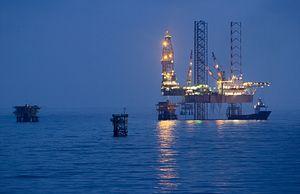The China National Offshore Oil Company (CNOOC) announced on September 15 that the HD981 oil rig has discovered a new gas field called Lingshui 17-2, some 150 kilometers south of Hainan. However, the gas field’s reserves, which are still being tested, are estimated at an average operational depth of 1,500 meters, signaling that China now has the technological capability to drill anywhere in the South China Sea (SCS).
How has China developed its offshore technology?
CNOOC was established on February 15, 1982 in Beijing in order to develop the offshore oil and gas industry, in line with the Open Door policy initiated by Deng Xiaoping in 1978. The Chinese petroleum industry was at that time under the control of Chinese Premier Li Peng and his deputy Kang Shien.
In the joint book Policy Making in China: Leaders, Structures, and Processes published by Princeton University Press in 1988, Kenneth Lieberthal and Michel Oksenberg discovered that Chinese leaders and petroleum officials had rushed to the U.S., Japan, the Netherlands, Norway and other Western countries to absorb offshore technology. Many delegations traveled to Houston, New Orleans and California to make contact with multinational petroleum companies, and they identified technology of short and longer-term importance. The authors further uncovered a Chinese strategy: to engage each of these companies, stimulate their interest in China, and then play them against each other. China revealed an ability to encourage several foreign entities to believe they were favored and had earned a particular confidence and friendship.
As a result, during the last decade of the 20th century multinational oil companies became major operators and bore the majority of expenses in the concession contracts, and then production sharing agreements (PSC), with the Chinese. Since 2002, when CNOOC for the first time held 51 percent interest in the joint venture QHD 23-6 oilfield with Chevron and BP, it has taken over the operation of most projects. CNOOC has since independently constructed offshore equipment such as the multi-functional investigation vessel HD709 in 2005, the large-scale deep water geographical vessel HD720 in 2010, and particularly, the semi-submersible oil rig HD981 in 2011.
The HD981 for example, is considered a 6th generation semi-submersible rig, which can operate in waters of 3,000 meters. It was designed in two steps: (i) by conducting a comparison of four platforms (the GVA7500m, F&G E&D, Aker H-4.3 and MSC DSS50), finally choosing the F&G E&D as the basis of the HD981; and (ii) through technical innovations in order to suit the extreme sea conditions of the SCS.
The F&G E&D design belongs to the Friede and Goldman Limited (F&G) in Houston. F&G has been a leader and innovator in offshore rig design for more than 60 years. More than 10 percent of the world’s fleet of jack-up rigs, and more than 20 percent of the semi-submersibles, are designed by F&G. In 2010 China Communications Construction Company Limited (CCCC) bought 100 percent of F&G, and viewed the acquisition as an important strategic step in expanding its offshore construction capabilities.
Meanwhile, Thomas M. Hout and Pankaj Ghemawat in the Harvard Business Review took a comprehensive view of Chinese technology, and noted that China is quietly and deliberately shifting from a successful low and middle-tech manufacturing economy to a sophisticated high-tech one by cajoling, co-opting, and often coercing Western and Japanese businesses.
What are the implications for the SCS?
First, CNOOC has become an active player in the SCS dispute. In June 2012, CNOOC offered an international tender for nine oil and gas blocks in the SCS. However, international companies showed hesitation and did not participate in the bidding because the area is within the exclusive economic zone (EEZ) and continental shelf of Vietnam. Moreover, the deployment of the HD981 in May 2014 also illustrates CNOOC’s role. Particularly during the launching ceremony of HD981 in Beijing, CNOOC Chairman Wang Yilin told audiences that large deepwater drilling rigs are “our mobile national territory and strategic weapon.” Meanwhile, Michele Nash-Hoff has argued that the massive acquisition of U.S. enterprises by China, including F&G, is a problem because China is using its companies as strategic tools for territorial disputes.
Second, multinational and international enterprises should be more aware of the “strategic aspect” of their business with Chinese companies for hydrocarbon exploration and development. In other words, helping China develop the capability for deep sea drilling is one thing. However, CNOOC’s international partners should be aware that the way they cooperate with China fuels tensions in the SCS, which could eventually create adverse business conditions.
Thuc D. Pham is a SCS researcher at the Diplomatic Academy of Vietnam. The opinions expressed in the article are those of the author and do not represent the views of institutions to which the author is attached.
































